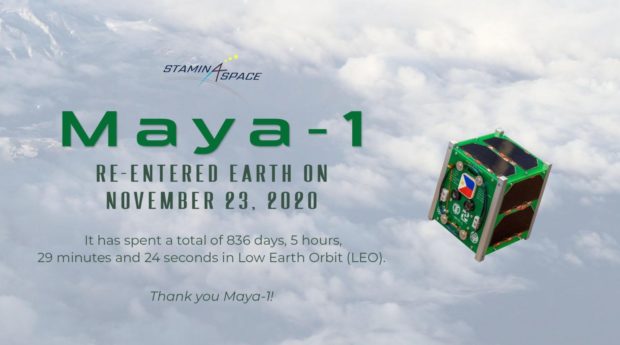
First Philippine-made nanosatellite Maya-1. Image: STAMINA4Space
The eagle — or rather, the maya — has landed.
Maya-1, the first nanosatellite of the Philippines, came back from space on Nov. 23 after two years orbiting the Earth, according to a statement on Friday, Nov. 27, from the Stamina4Space program, which is funded by the Department of Science and Technology (DOST).
The cube satellite lasted 836 days, 5 hours, 29 minutes and 24 seconds in Low Earth Orbit.
Making the achievement even more remarkable is that it was only expected to stay in orbit for less than a year, said graduate student Adrian Salces, who helped develop Maya-1.
Salces developed Maya-1 with fellow graduate student Joven Javier under a research program called the Development of Scientific Earth Observation Microsatellite (PHL-Microsat) program. It is implemented by the University of the Philippines-Diliman and DOST’s Advanced Science and Technology Institute in partnership with Japan’s Kyushu Institute of Technology.
(L-R) Adrian Salces, Dr. Joel Joseph Marciano Jr, and Joven Javier. Javier and Salces developed Maya-1 in Japan, whereas Dr. Marciano is the program leader of PHL-Microsat.Image: PHL-Microsat via DOST-ASTI.
Maya-1, named after the maya bird (Chestnut munia), was sent to space on the SpaceX Falcon 9 Rocket last June 29, 2018. The rocket launched from the Kennedy Space Center in Florida.
The cube, weighing at just over a kilo, is equipped with handy scientific instruments, such as two cameras that can take photos of the Earth. One of its missions was a store-and-forward system, where it would collect data from ground sensor terminals in its footprint. It would save the data and forward it to a member ground station. It also has a GPS and a magnetometer, which measures the magnetic field in space.
The development of Maya-1 has paved the way for more CubeSats — Maya-5 and Maya-6 are already in the making. Maya-2 was turned over to the Japan Aerospace Exploration Agency last September.
Philippine Space Agency director-general Joel Joseph Marciano, Jr. hopes that eventually high school students will be able to build these nanosatellites, which are a cost-effective way to do space research in the country.
The first Philippine-made satellite, Diwata-1, was sent to space in March 2016 and returned to Earth in April 2020. JB
RELATED STORIES:
Mapua student wins award for invention that harvests solar energy from waste produce
‘Street astronomers’ give pandemic-stricken Filipinos much-needed glimpses of outer space